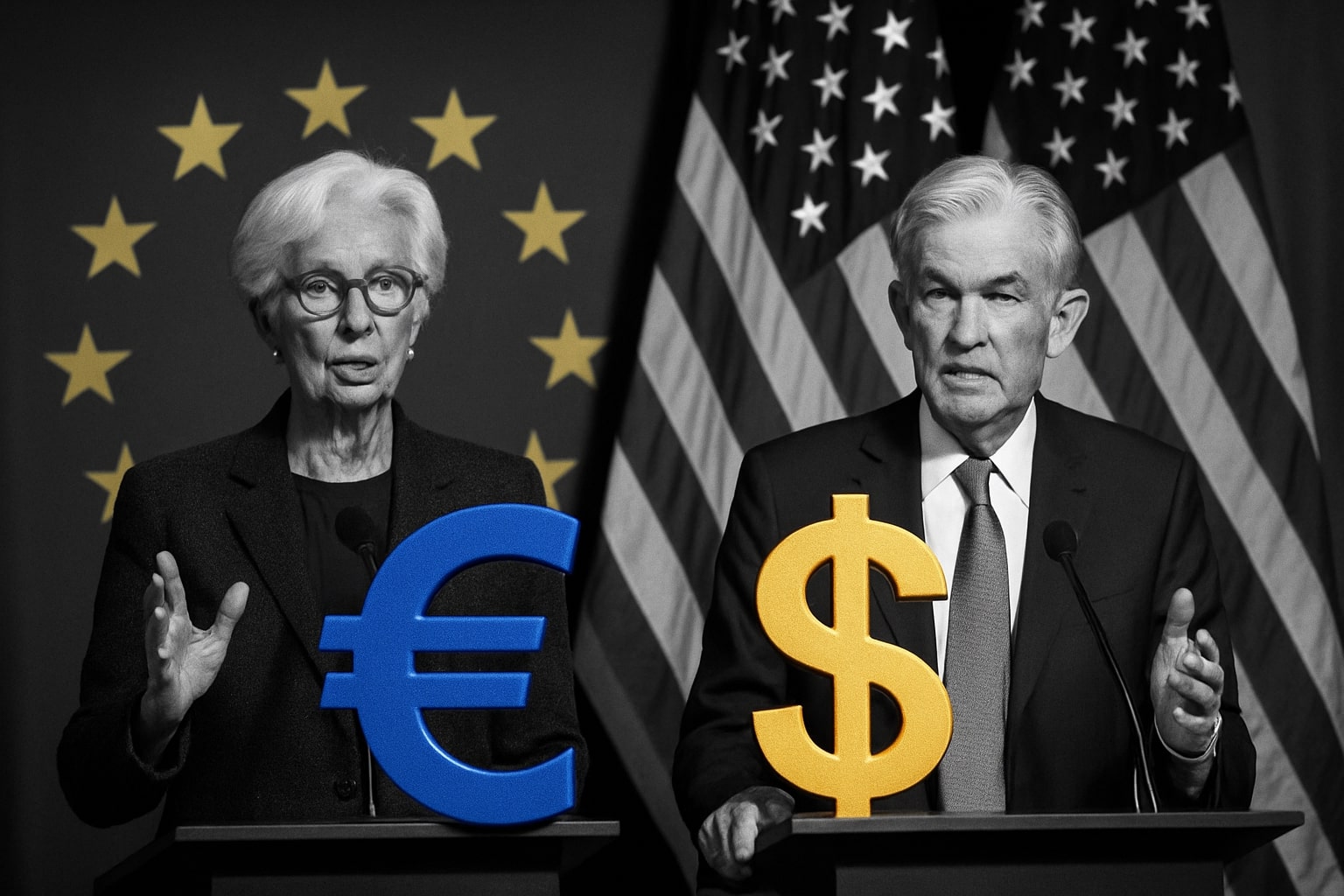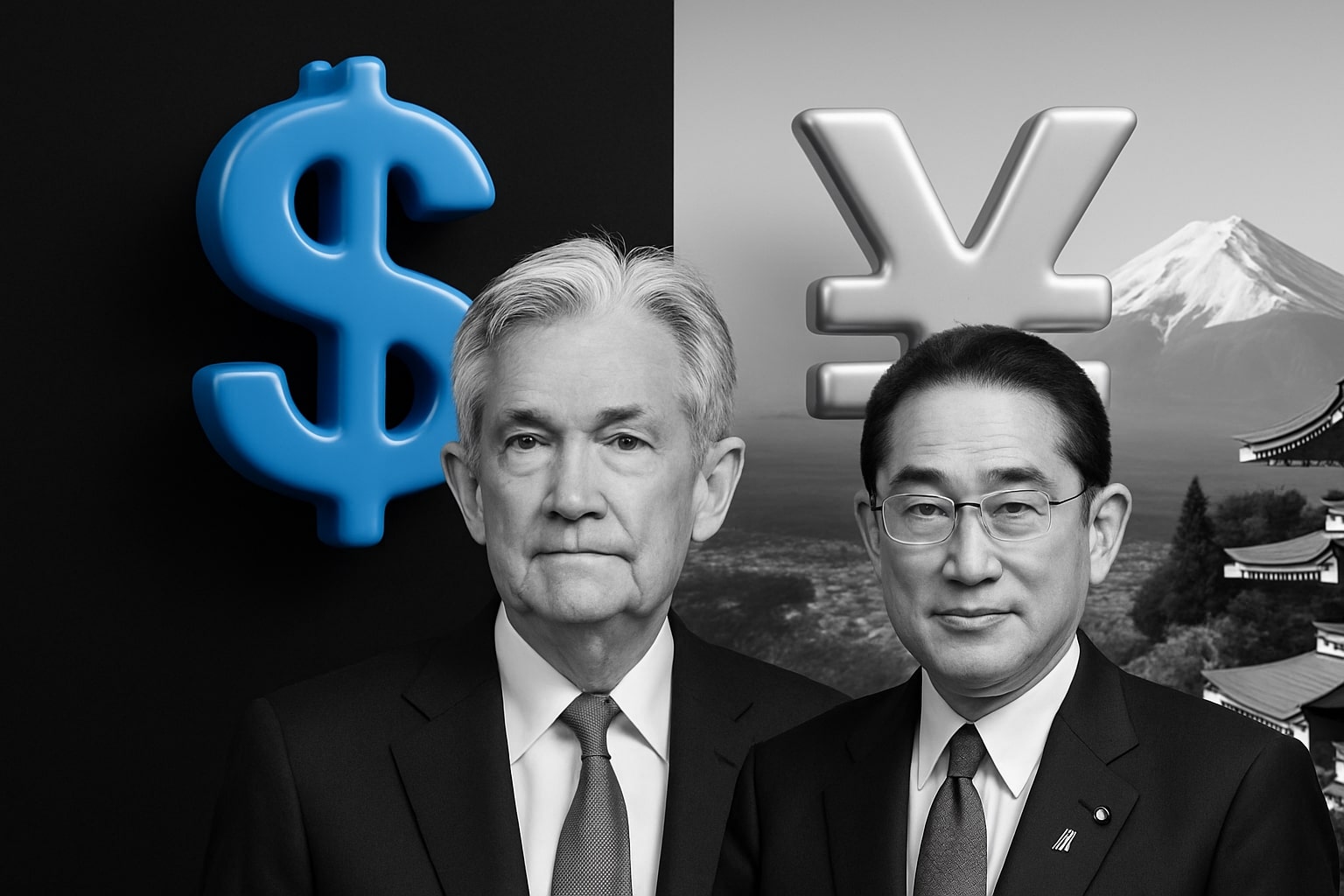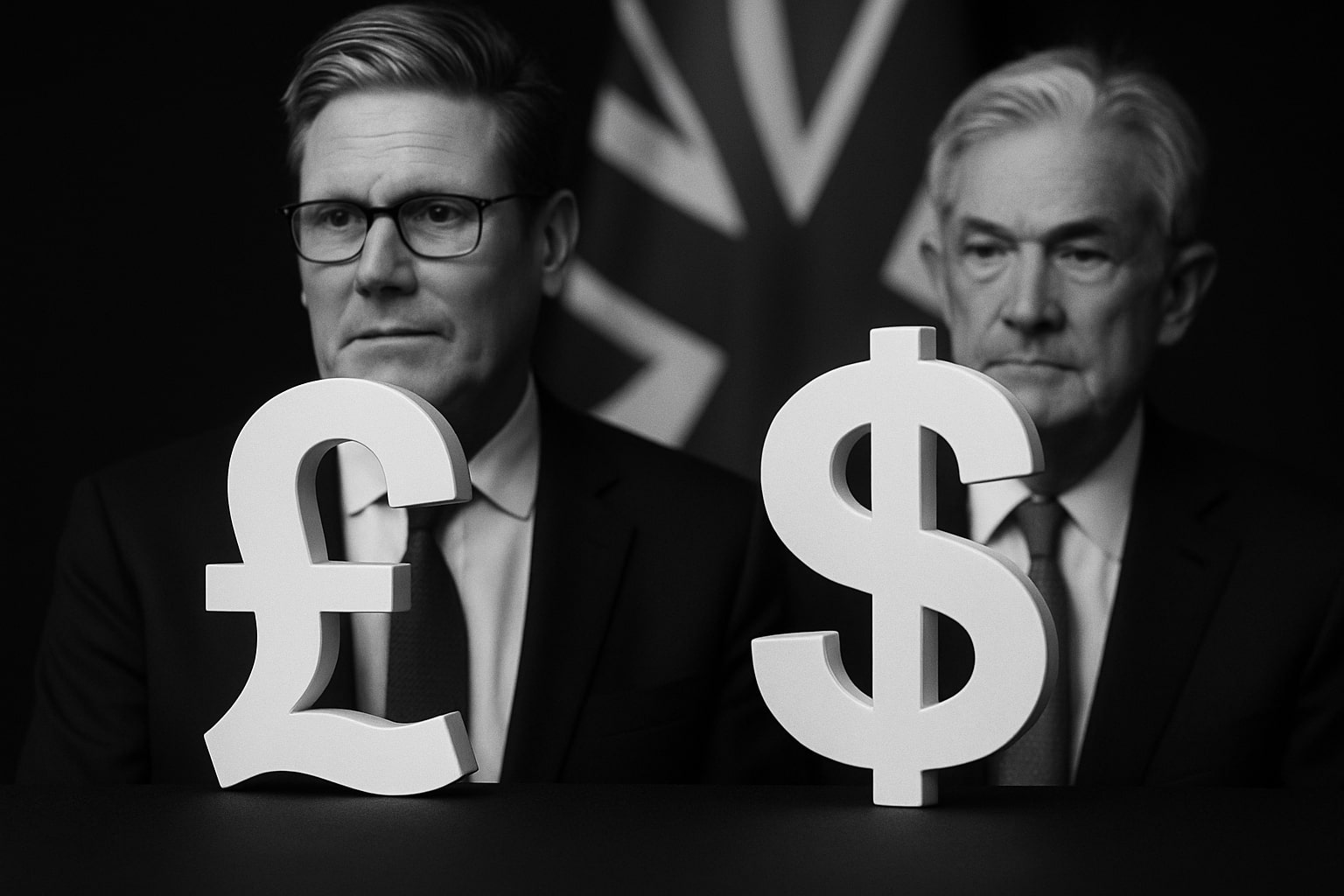
GBP/USD Price Forecast - Pound Slides Toward 1.3050 as Hawkish Fed and Weak UK CPI
The British Pound (GBP/USD) remains under pressure after UK inflation cooled to 3.6% and BoE rate-cut odds hit 74%, while Fed officials signal no near-term easing | That's TradingNEWS
GBP/USD Tests 1.3050 as Dollar Strength, Cooling U.K. Inflation, and Fed Hawkishness Pressure Sterling
The British pound (GBP/USD) remains under intense downward pressure, trading near 1.3050 after sliding from 1.3215 earlier in the week. The pair has fallen for four consecutive sessions, weighed by hawkish Federal Reserve minutes, weaker U.K. inflation data, and growing speculation that the Bank of England (BoE) could cut rates as early as December. The setup marks a crucial juncture for Sterling, as price action hovers at pivotal support near the 1.3080–1.3050 zone, a level repeatedly tested since March 2024.
The GBP/USD correction began after the Fed minutes confirmed that most officials now favor keeping policy restrictive for longer, with December rate-cut odds plunging to 31%, down from 46% last week. That repricing lifted the U.S. Dollar Index (DXY) above 100.00, its highest in five months, while Treasury yields climbed, amplifying the dollar’s carry advantage. The result has been a decisive reversal in Sterling’s recent momentum, with traders reducing bullish exposure ahead of key macro catalysts.
U.K. Inflation Eases, Cementing Rate-Cut Expectations
Data from the Office for National Statistics (ONS) showed that headline CPI slowed to 3.6% year-over-year in October, down from 3.8% in September, while core CPI dropped to 3.4%, the lowest since March. The Retail Price Index also fell to 4.3% from 4.5%, signaling broad disinflation across goods and services.
Markets immediately priced in a 25-basis-point BoE rate cut, with Deutsche Bank and UOB analysts now expecting the benchmark rate to drop to 4.00% by December. The soft inflation reading, combined with sluggish GDP growth and a cooling labor market, reinforced the view that the BoE’s tightening cycle has peaked. Traders now assign a 74% probability to a cut at the next meeting, a sharp pivot from earlier in the quarter when expectations were for policy to remain unchanged through Q1 2026.
The BoE’s dovish tilt contrasts sharply with the Fed’s stance, intensifying downward pressure on the pound. The divergence between the two central banks’ outlooks has widened the interest rate differential by nearly 70 basis points in favor of the dollar, the largest since mid-2023.
Fed Hawkishness Reinforces Dollar Dominance
The Fed minutes released on Tuesday confirmed policymakers’ concern that easing too soon could reignite inflation. Chair Jerome Powell and other FOMC members stressed the need to maintain restrictive policy until “clear disinflationary momentum” is achieved. With the CME FedWatch Tool showing just a 30% chance of a December rate cut, traders shifted sharply back into the dollar, driving GBP/USD below the critical 1.3080 pivot.
Further evidence of U.S. economic resilience came from regional data: Kansas Fed manufacturing activity rose to 18 from 15, and Existing Home Sales improved to 4.10 million, beating the 4.08 million consensus. This series of positive releases strengthened the case for the Fed’s extended pause, boosting the dollar’s yield premium across major pairs, including GBP/USD.
Technical Breakdown and Bearish Structure
The GBP/USD pair’s technical structure has deteriorated sharply. The price has fallen below both the 50-day and 200-day exponential moving averages, signaling a sustained bearish bias. The narrowing gap between the two EMAs points to an impending death cross, a classic signal of deeper downside momentum.
The pair also broke beneath the 38.2% Fibonacci retracement of its September-to-November rally at 1.3156, confirming a structural shift. Current support stands at 1.3050, followed by 1.2955, representing the 50% Fibonacci retracement. A decisive daily close below 1.3010 would open the path toward 1.2895, a level corresponding to the March 2024 high and a major psychological threshold.
Momentum indicators reinforce this view. The RSI remains near 40, reflecting weak recovery potential, while MACD histograms stay negative, confirming persistent selling pressure. On the weekly chart, 1.3080–1.3050 aligns with the 100% extension of the decline from yearly highs, a zone that has historically triggered short-term rebounds. However, without a close above 1.3140–1.3220, Sterling’s upside remains capped.
BoE’s Fiscal Constraints and Political Risks Intensify Sterling’s Weakness
Sterling’s vulnerability extends beyond monetary policy. Political and fiscal uncertainty are re-emerging as risk factors. The upcoming Autumn Budget from Chancellor Rachel Reeves, scheduled for November 26, could extend the income tax threshold freeze, constraining disposable income and potentially reigniting market volatility in U.K. gilts.Investor confidence is already fragile after weak GDP growth (+0.2% QoQ) and signs of stagnation in private investment. Combined with a fiscal deficit near 4.9% of GDP, the policy mix of easing and high public spending risks widening the pound’s structural imbalance against the dollar.
Read More
-
Meta Stock Price Forecast - Meta Faces $16B Tax Blow and $100B CapEx Shock as Shares Sink to $587
20.11.2025 · TradingNEWS ArchiveStocks
-
XRP Price Forecast - XRP-USD Tests $2.00 as XRP ETF Boom Fails to Halt 11% Weekly Drop
20.11.2025 · TradingNEWS ArchiveCrypto
-
Oil Price Forecast - Oil Prices Recover as U.S. Draw Depletes 3.4M Barrels
20.11.2025 · TradingNEWS ArchiveCommodities
-
Stock Market Today: NVDA +5%, WMT +6%, TSLA +5% Drive Nasdaq to 23,045 in Explosive AI-Led Rally
20.11.2025 · TradingNEWS ArchiveMarkets
-
EUR/USD Price Forecast - Euro Falls Toward 1.1530 as Fed Tightens Tone
20.11.2025 · TradingNEWS ArchiveForex
U.S. Labor Market Strength and Delayed NFP Report Create Volatility Risk
The U.S. Bureau of Labor Statistics (BLS) delay of the October Non-Farm Payrolls (NFP) report due to the brief federal shutdown has heightened market uncertainty. Expectations are for a gain of +55,000 jobs, following +22,000 in the previous month. Any surprise above that range would reinforce the Fed’s hawkish bias and accelerate the next leg down in GBP/USD.
Historically, every 50,000-job beat in NFP has added 0.5–0.6% to the U.S. Dollar Index, which would equate to a move in GBP/USD toward 1.2950 within a single session. Traders are already positioning short, with CFTC data showing a net –35,000 GBP contracts, up 14% week-on-week.
Market Sentiment and Positioning Reflect Deep Bearish Bias
Institutional sentiment continues to favor the dollar. Hedge funds and asset managers have increased USD long exposure by $2.4 billion since mid-November, while retail positioning on GBP/USD remains skewed 63% net-long, suggesting retail traders are trying to bottom-fish—a signal that often precedes additional declines.
Implied volatility for one-week GBP/USD options jumped to 9.3%, its highest level since August, reflecting expectations of heavy fluctuations around the NFP release and BoE’s December policy meeting.
Key Support and Resistance Levels
-
Immediate resistance: 1.3090 → 1.3155 → 1.3220
-
Immediate support: 1.3050 → 1.2955 → 1.2890 → 1.2745
-
200-day EMA: 1.3146
-
RSI (daily): 40.8
-
MACD: Bearish continuation
A weekly close below 1.3080 would confirm a resumption of the downtrend from 1.3800, with the next downside target near 1.2745, corresponding to the 61.8% retracement of the yearly range.
Broader Macro Context: Dollar Resilience vs. Sterling Fragility
The macro divergence is now unmistakable. The U.S. economy, expanding at 2.1% annualized in Q3, continues to outperform the U.K.’s 0.4% annualized rate. Wage growth in the U.S. remains at 3.8% YoY, while U.K. earnings excluding bonuses fell below 6.0%, their slowest pace in 18 months.
This yield and growth differential cements dollar dominance. The 10-year U.S. Treasury yield trades at 4.12%, while the 10-year U.K. gilt yield has fallen to 3.74%, deepening real rate divergence and reducing Sterling’s attractiveness for yield-seeking investors.
Technical Scenarios and Strategy Outlook
If GBP/USD holds above 1.3050 and rebounds through 1.3155, short-covering could lift it to 1.3220, though sellers are expected to defend that area aggressively. A clean break below 1.3010 would accelerate losses toward 1.2895, and potentially 1.2745, where long-term Fibonacci and structural supports converge.
Volume profiles show heavy institutional sell orders concentrated between 1.3140–1.3220, confirming that any rally will likely face strong resistance before trend reversal is possible.
Verdict: GBP/USD — SELL / SHORT-TERM BEARISH
The GBP/USD remains structurally bearish as macro, technical, and sentiment data align against Sterling. The combination of BoE rate-cut expectations, U.K. disinflation, and Fed hawkishness keeps downside risk dominant. A decisive break below 1.3010 would open room for 1.2890, while any bounce toward 1.3155 should be viewed as corrective within a downtrend.



















